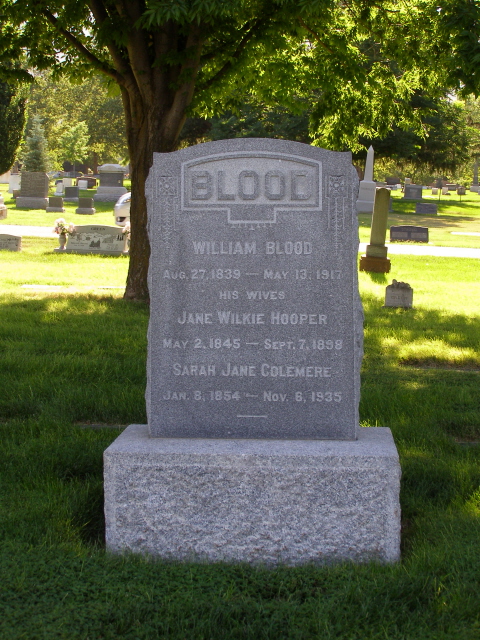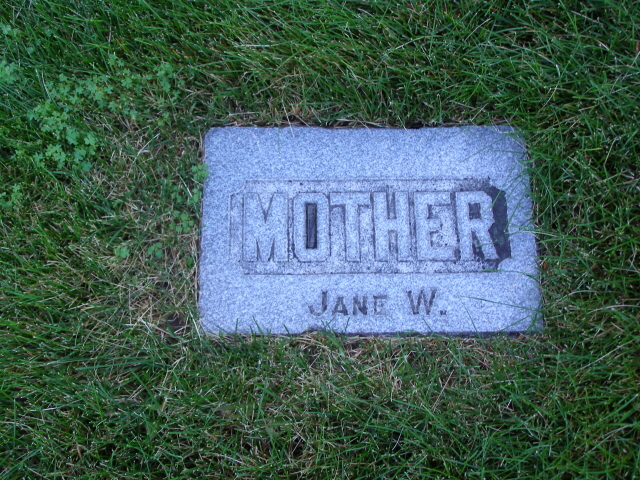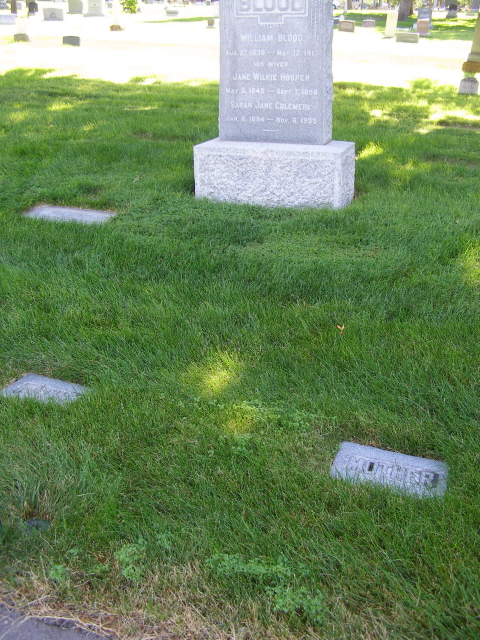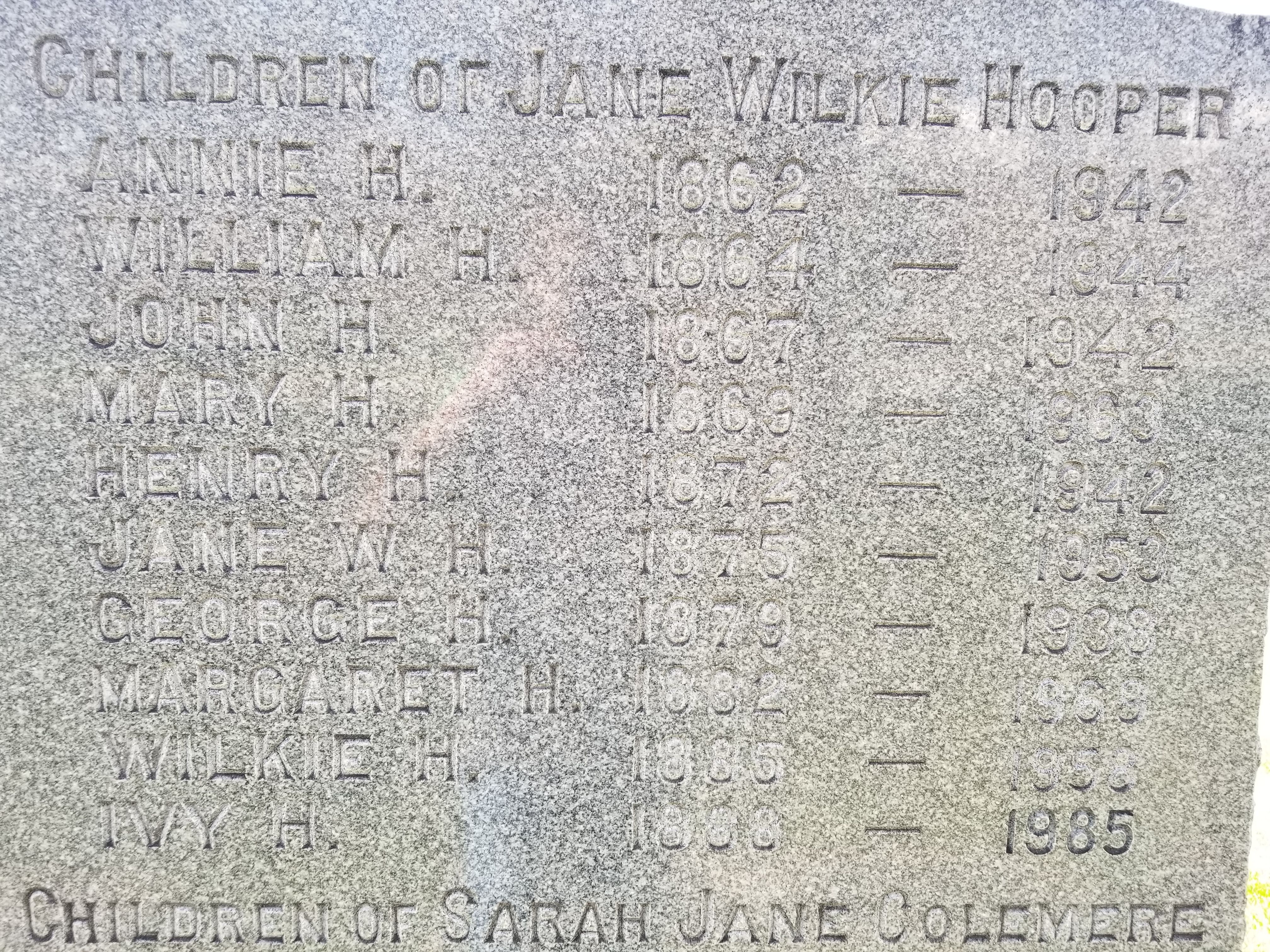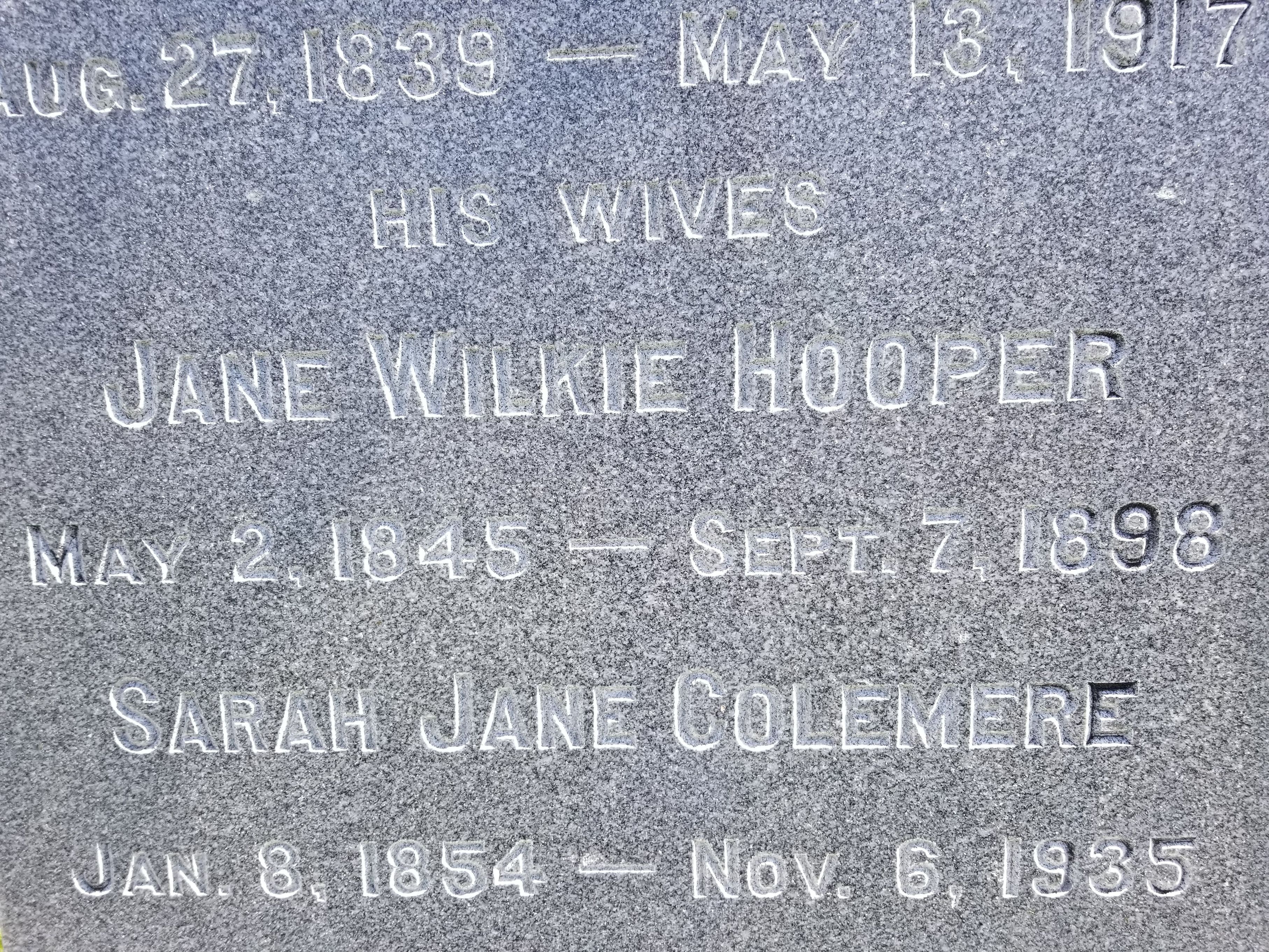Married William Blood, 9 Sep 1861, Kaysville, Davis, Utah
Children - Annie Hooper Blood, William Hooper Blood, John Hooper Blood, Mary Hooper Blood, Henry Hooper Blood, Jane Wilkie Hooper Blood, George Hooper Blood, Ernest Coleman Blood, Margaret Hooper Blood, Wilkie Hooper Blood, Ivy Hooper Blood, Donnetta Coleman Blood
History. When Jane was six months old she was left in the care of her grandparents and older sister while her mother and father served as steward and stewardess on a ship. In 1847, they moved to Bristol where they first heard the Mormon message and became interested in their teaching. In 1852, Jane's mother joined the church and later the entire family joined. Jane was a frail, delicate child. She was baptized at eight years of age. Because of the persecutions at the time, she was baptized after dark. The Elder carried her into the ocean to where the water was deep enough and then he baptized her.
Their family left for Zion, in January 1854, sailing from Liverpool on the ship "Golconda." On July 3, 1854, they started across the Plains to Salt Lake City. As her parents had traveled in Europe, they had purchased many beautiful things such as carpets, linens, silks, dishes, and silverware which they brought with them. They purchased three wagons and oxen to carry the load.
Because their wagons were so heavily loaded, it was necessary for the family to walk most of the way. On one occasion, two of the oxen gave out and Jane was sent back to tell the herders to bring some other cattle for them. In the bustle of the family changing the cattle and fording the Green River, Jane was left behind. She was very frightened when she found that she was on the other side of the river alone. Finally, a man of the company who had been hunting came along and took her on his back and forded the river. She always remembered how glad her mother was when she saw them coming.
What a change these hardships of crossing the Plains were for a nine-year-old girl raised as she had been, for she had never even dressed herself alone until she left England. They arrived in Salt Lake, on October 3, 1854. Her father bought a farm in Kaysville in the spring of 1855. The family camped out all summer and in the fall her father made a dugout in the side of a hill.
The first night they were in the dugout, there was a terrible east wind that took off the roof completely and covered everything with dirt. Jane had to herd cows and work in the fields. She was excellent at binding grain and doing other farm work. Education was not too available so what she learned was at home. Her mother and grandmother taught her to do needlework.
She helped fix clothes and provisions for the men of the army with the threat of Johnston's Army. The family moved to Spanish Fork where they had plenty of fish from Utah Lake. When the threat was over, they returned to their home in time to harvest their crops. They later purchased a home in Ogden where Jane lived until she was married, on September 9, 1861, to William Blood.
The Winter of 1855 was known as the "hard winter," with snow three feet deep and crusted so it was impossible for the cattle to break through to get food. Jane wrote,"I shall never forget that Christmas when we heard the roar of the starving cattle as they came bellowing into our settlement. Men had to drive back those who were able to walk. Many fell dead because the people were unable to feed them. The men went from yard to yard to lift the animals to their feet."
The summer following was one of draught. Very little grain matured so food stuff was scarce. The Hooper family had enough food for their needs, but they could not eat without dividing it with neighbors and married children, so by spring they too were living on greens, barley, or anything that could be used as food.
Jane and William made their home in Kaysville. They had one large room with a dirt roof. They had one small kettle and a bake skillet for bread and cooked in a fireplace. In March 1867, they moved into a six-bedroom adobe house opposite the Tabernacle. Jane lived there for the remainder of her life.
William worked for the Union Pacific Railroad in Weber Canyon. He came home only on weekends. Jane cared for her little ones and made hair nets out of coarse silk twist with a design beaded in the center from which she earned considerable money.
Jane was always interested in education. Because she had little opportunity as a child, she and William attended night school after they were married.
Jane served in the Relief Society from the time of its organization in Kaysville until her death. She taught a class in Sunday School and when the primary was organized in 1879, she was made President of that organization, a position she also held until her death nineteen years later. When she was in poor health and could not go to the meeting house, she would have the children meet at her home. She loved the children, and loved to work with them.
She was also gifted in caring for the sick. When there were no doctors to be called in, she was called day or night to assist. She often cared for the dead and made burial clothes. Often she would change her clothing in the granary after assisting where there was a contagious disease so she would not carry it to her family, but she would never refuse to go to help with the sick. She spent her life doing good wherever she could. It was her desire and custom as long as she lived, to have all of her family at home each Sunday and holiday.
Jane passed away at her home, September 7, 1898, at the age of fifty-three years.
Married William Blood, 9 Sep 1861, Kaysville, Davis, Utah
Children - Annie Hooper Blood, William Hooper Blood, John Hooper Blood, Mary Hooper Blood, Henry Hooper Blood, Jane Wilkie Hooper Blood, George Hooper Blood, Ernest Coleman Blood, Margaret Hooper Blood, Wilkie Hooper Blood, Ivy Hooper Blood, Donnetta Coleman Blood
History. When Jane was six months old she was left in the care of her grandparents and older sister while her mother and father served as steward and stewardess on a ship. In 1847, they moved to Bristol where they first heard the Mormon message and became interested in their teaching. In 1852, Jane's mother joined the church and later the entire family joined. Jane was a frail, delicate child. She was baptized at eight years of age. Because of the persecutions at the time, she was baptized after dark. The Elder carried her into the ocean to where the water was deep enough and then he baptized her.
Their family left for Zion, in January 1854, sailing from Liverpool on the ship "Golconda." On July 3, 1854, they started across the Plains to Salt Lake City. As her parents had traveled in Europe, they had purchased many beautiful things such as carpets, linens, silks, dishes, and silverware which they brought with them. They purchased three wagons and oxen to carry the load.
Because their wagons were so heavily loaded, it was necessary for the family to walk most of the way. On one occasion, two of the oxen gave out and Jane was sent back to tell the herders to bring some other cattle for them. In the bustle of the family changing the cattle and fording the Green River, Jane was left behind. She was very frightened when she found that she was on the other side of the river alone. Finally, a man of the company who had been hunting came along and took her on his back and forded the river. She always remembered how glad her mother was when she saw them coming.
What a change these hardships of crossing the Plains were for a nine-year-old girl raised as she had been, for she had never even dressed herself alone until she left England. They arrived in Salt Lake, on October 3, 1854. Her father bought a farm in Kaysville in the spring of 1855. The family camped out all summer and in the fall her father made a dugout in the side of a hill.
The first night they were in the dugout, there was a terrible east wind that took off the roof completely and covered everything with dirt. Jane had to herd cows and work in the fields. She was excellent at binding grain and doing other farm work. Education was not too available so what she learned was at home. Her mother and grandmother taught her to do needlework.
She helped fix clothes and provisions for the men of the army with the threat of Johnston's Army. The family moved to Spanish Fork where they had plenty of fish from Utah Lake. When the threat was over, they returned to their home in time to harvest their crops. They later purchased a home in Ogden where Jane lived until she was married, on September 9, 1861, to William Blood.
The Winter of 1855 was known as the "hard winter," with snow three feet deep and crusted so it was impossible for the cattle to break through to get food. Jane wrote,"I shall never forget that Christmas when we heard the roar of the starving cattle as they came bellowing into our settlement. Men had to drive back those who were able to walk. Many fell dead because the people were unable to feed them. The men went from yard to yard to lift the animals to their feet."
The summer following was one of draught. Very little grain matured so food stuff was scarce. The Hooper family had enough food for their needs, but they could not eat without dividing it with neighbors and married children, so by spring they too were living on greens, barley, or anything that could be used as food.
Jane and William made their home in Kaysville. They had one large room with a dirt roof. They had one small kettle and a bake skillet for bread and cooked in a fireplace. In March 1867, they moved into a six-bedroom adobe house opposite the Tabernacle. Jane lived there for the remainder of her life.
William worked for the Union Pacific Railroad in Weber Canyon. He came home only on weekends. Jane cared for her little ones and made hair nets out of coarse silk twist with a design beaded in the center from which she earned considerable money.
Jane was always interested in education. Because she had little opportunity as a child, she and William attended night school after they were married.
Jane served in the Relief Society from the time of its organization in Kaysville until her death. She taught a class in Sunday School and when the primary was organized in 1879, she was made President of that organization, a position she also held until her death nineteen years later. When she was in poor health and could not go to the meeting house, she would have the children meet at her home. She loved the children, and loved to work with them.
She was also gifted in caring for the sick. When there were no doctors to be called in, she was called day or night to assist. She often cared for the dead and made burial clothes. Often she would change her clothing in the granary after assisting where there was a contagious disease so she would not carry it to her family, but she would never refuse to go to help with the sick. She spent her life doing good wherever she could. It was her desire and custom as long as she lived, to have all of her family at home each Sunday and holiday.
Jane passed away at her home, September 7, 1898, at the age of fifty-three years.
Family Members
Advertisement
Explore more
Sponsored by Ancestry
Advertisement



















